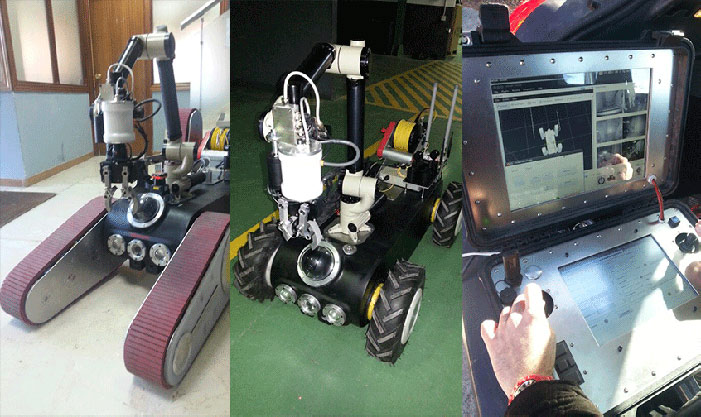In the field of hostile conditions, space is often considered as the harsh environment at its height. However, it’s not necessary to go so far away to find out other situations with such extreme conditions like high temperatures, freezing cold (for example arctic missions), humidity, high pressure level (like in oceanic trench), reduced accessibility (in pipelines for example) or every risk in relation with CBRN field.
To begin with, let’s talk about the CBRN (Chemical – Biological – Radiological – Nuclear) defence, and more precisely, how unmanned defence robotics can be profitable, even essential to human beings. First, it can be used to reduce human labour, because it is too dangerous and/or expensive. Then, a robot can be useful to achieve some tasks just impossible to complete by a human operator. Indeed, this kind of application can take place in an accidentally contaminated scenario (like a nuclear disaster) but also in an intentionally contaminated scenario (like a terrorist act or the use of biologic weapon). In short, the more the environment presents a threat, the more unmanned specialised robots come on stage. The following pictures show the RESCUER CBRN robot developed by Robotnik, in its two kinematic configurations and the tests done in a CBRN intervention mission with real radiological samples for the Spanish UME (Military Emergency Unit). The most remarkable capability of this platform besides its high mobility, is that is has been designed for decontamination, i.e. the complete mobile manipulator is IP67 waterproof.
Nevertheless, there are some foreseen and planned events where specialised robots in CBRN environment have their role to play. For example, in case of a nuclear reactor dismantling, to use a robot presents a real interest compared to sending human operators. Assuming that a human would be allowed to operate in such a dangerous environment, without hazard to his life, this option would be very tiring (full protective clothing), time-consuming, poorly performing, dangerous and expensive.
During the European Robotics Forum 2016, Thomas Vögele, from the DFKI Robotics Innovation Center in Bremen, and Joël Vanden Bosch, from Cybernetix, presented some concept strategies and lessons learned to develop a robot well suited for harsh environment. In order to improve the reliability, it is very important to start from scratch with a new simple design concept, with intrinsically robust technologies instead of working from a conventional model without many improvement possibilities. In the same way, the hardware and software, even if it has been tested many times, should not be considered at its peak but a part that must be improved, among other things in order to make the robot more reliable and smarter. Besides, the team has to know what to expect, that is to say, a very long development phase, to reach the commercial stage, where a strong partnership is essential with the end-users, to fully understand the need and to be sure to go on the right track. Furthermore, a big effort is necessary in the test phase, which has to be thorough. Indeed, designing and sizing a robot in the classic way, with common materials or without redundancy for example, can be sufficient for a normal environment, but far too little in harsh conditions. That’s why it can be necessary to develop a full scale model to focus the trials and if possible, to integrate risk management in the development strategy. In fact, the reliability of the robot is even more important due to the high difficulty of a recovery mission in case of system damage in a hazardous environment. And to finish with, another key point in the development success is getting a training centre and a 3D virtual reality simulation room to constantly improve the system.
Robotic intervention in harsh environments is a growing sector with potential health and environmental risks associated and where the improvement is an absolute necessity. Likewise, it requires much more efforts, resources and the environment knowledge to successfully develop a robot for harsh environments, but holding all the cards, there is no reason to hesitate to go with robots where humans don’t go anymore.


